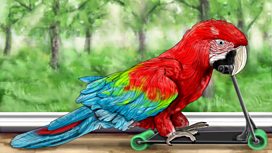Hornbill
Brett Westwood explores how hornbills have influenced art, religion and feminism. Their bizarre looks, strange breeding behaviour and carvable beaks have thrust them into society.
Exotic and bizarre, hornbills wowed European society when the first live specimens arrived in the nineteenth century. Their almost human like walk combined with their unbelievable bills and strange calls presented an image of nature most Europeans had never encountered. When their odd breeding behaviour became known - the males seal up the female in a hole in a tree cavity so that only her beak can protrude for weeks on end - they became great curiosities. The bill of the helmeted hornbill was particularly prized for carving the Victorian obsession - netsuke. Beautifully coloured, especially if reddened by the oil from a preen gland, the "ivory" became the most sought after material for Victorian display cabinets. Hornbill ivory is still so highly prized by the Chinese that the helmeted hornbill is on the verge of extinction; its bill fetches a higher price than elephant ivory. However in their Indonesian homeland they are seen as mythical creatures that guard the thin veil between life and death, ferrying souls between the earth and heaven. This sacred belief is now being used by modern conservationists to help protect them as they disappear at an alarming rate from the face of the earth. Because many of the Asian Hornbills nest in the largest trees, they are at greatest risk from loggers, legal or illegal, and therefore stand as flagship species for forest conservation in SE Asia.
Last on
![]()
Comedy: The World According to Hornbill
A Hornbill struggles with fatherhood: "This sounds horrible, but they're so ugly!"
![]()
Chicks due any minute? Looking for your ideal nest? Don’t brood, browse!
![]()
Producer Mary Colwell writes about the bird that's more valuable than ivory.
![]()
Tweet of the Day
Miranda Krestovnikoff introduces the African southern ground hornbill.
![]()
Parrots
Brett Westwood explores parrots and their effect on art, literature and society.
Clips
-
![]()
‘The female seals herself into a natural hole’
Duration: 01:14
-
![]()
The World According to Hornbill
Duration: 01:57
Dr Joanne Cooper

After nearly 20 years working on the skeleton collection in particular, she has become an internationally recognised authority in avian osteology and has particular experience and expertise in the taxonomic identification of bird bones.
She is interested in the history of the bird collections, and is currently investigating Charles Darwin’s domestic birds, Captain Fitzroy’s bird collection from the famous 1831-36 voyage of HMS Beagle and John Gould’s collection of hummingbird cases.
Mark Gordon

He has maintained a passionate life-long interest in Southeast Asian Tribal Art. He has assembled a world-class collection of more than 400 pieces that has been exhibited in museums and galleries in Asia and featured in numerous publications, including the illustrated book, .
Dr Alan Kemp

He and Meg work with the , which re-introduces hand-reared ground hornbill chicks into areas where they have become locally extinct, once the original threats in those areas have been mitigated.
The project also researches the genetics, behaviour and other important unanswered questions necessary for successful re-establishment of ground hornbills and runs awareness campaigns to educate the general public to the threats facing the species and to reinstate the bird into collective memory in areas where it has become locally extinct.
Andrew Owen

Now at , he is actively involved in many field conservation projects in Mauritius and South East Asia. One of his projects is looking at the critically endangered songbirds of Bali, many of which will feature in a huge free flight aviary in Chester Zoo’s Monsoon Forest – the UK’s largest ever indoor zoo exhibit. He is the European studbook keeper for the Sumatran Laughingthrush.
Broadcasts
- Tue 13 Oct 2015 11:00�鶹�� Radio 4 FM
- Mon 19 Oct 2015 21:00�鶹�� Radio 4









